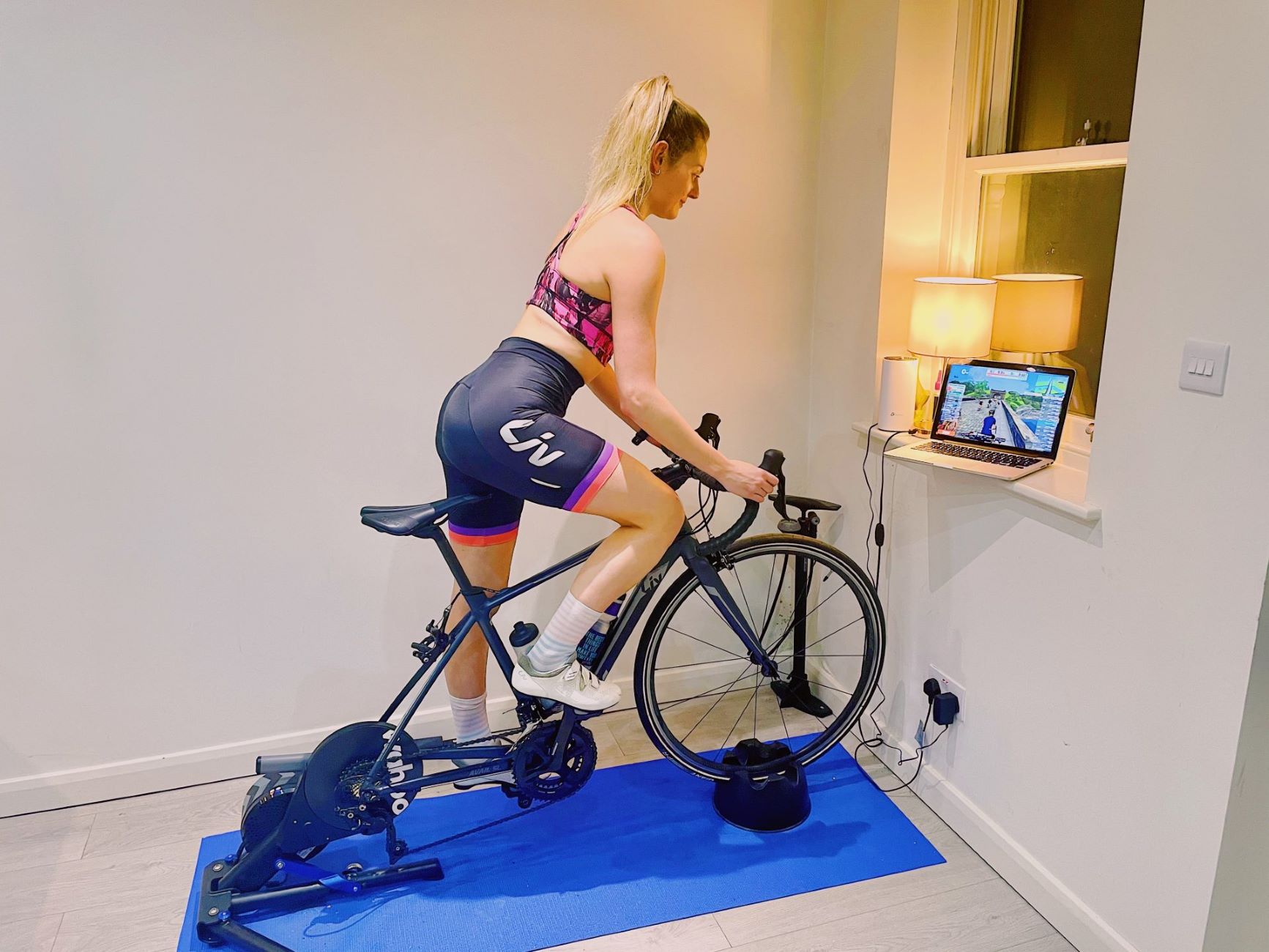Home>Training & Techniques>Cross-Training>Using Indoor Cycling To Enhance Your Running Fitness During Lockdown


Cross-Training
Using Indoor Cycling To Enhance Your Running Fitness During Lockdown
Published: February 20, 2024
Discover how indoor cycling can boost your running fitness during lockdown. Learn the benefits of cross-training and maximize your workout routine.
(Many of the links in this article redirect to a specific reviewed product. Your purchase of these products through affiliate links helps to generate commission for Therunningadvisor.com, at no extra cost. Learn more)
Table of Contents
Benefits of Indoor Cycling for Runners
Indoor cycling is a powerful cross-training tool that offers numerous benefits for runners. Incorporating indoor cycling into your training routine can significantly enhance your running fitness, improve overall performance, and reduce the risk of injury. Here are some key advantages of integrating indoor cycling into your running regimen:
-
Low-Impact Cardiovascular Workout: Cycling provides an effective cardiovascular workout without the high-impact stress on your joints that often accompanies running. This low-impact nature makes it an ideal cross-training activity, allowing you to boost your endurance and aerobic capacity while giving your running muscles a break from the repetitive pounding of the pavement.
-
Muscle Strengthening and Balance: Indoor cycling engages different muscle groups, particularly the quadriceps, hamstrings, and glutes, which are essential for running. By strengthening these muscles through cycling, you can improve your overall muscular balance and stability, leading to enhanced running performance and reduced risk of muscle imbalances and injuries.
-
Active Recovery and Injury Prevention: Cycling serves as an excellent form of active recovery for runners. It promotes blood flow to the muscles, aiding in the repair and recovery process after intense running sessions. Additionally, the circular motion of pedaling helps to loosen tight muscles and alleviate stiffness, reducing the likelihood of overuse injuries.
-
Variety and Mental Refreshment: Incorporating indoor cycling into your training routine adds variety and mental refreshment. Breaking away from the monotony of running can reignite your motivation and enthusiasm for training, preventing burnout and keeping your workouts enjoyable and engaging.
-
Weather-Independent Training: With indoor cycling, you can maintain your training consistency regardless of the weather conditions outside. This is particularly beneficial during lockdowns or inclement weather when outdoor running may not be feasible. Indoor cycling provides a reliable alternative to ensure that you can continue your training without interruptions.
-
Customizable Intensity and Cross-Training Flexibility: Indoor cycling allows for precise control over resistance and intensity levels, enabling you to tailor your workouts to complement your running training. Whether you're focusing on endurance, strength, or recovery, indoor cycling offers the flexibility to adjust the intensity according to your specific training goals.
By leveraging the benefits of indoor cycling, runners can optimize their overall fitness, minimize the risk of overuse injuries, and maintain training consistency, ultimately leading to improved performance on the roads and trails.
Setting Up Your Indoor Cycling Space
Creating a dedicated indoor cycling space within your home is essential for optimizing your cross-training experience. By establishing a well-equipped and comfortable environment, you can maximize the effectiveness of your indoor cycling sessions and seamlessly integrate them into your overall training routine.
Selecting the Ideal Location
When setting up your indoor cycling space, choose a location that offers ample space for your equipment and allows for unrestricted movement during workouts. Ideally, select a well-ventilated area with sufficient natural light to create an inviting and energizing atmosphere. Additionally, consider placing your indoor cycling setup near a window or a motivational focal point to enhance the overall ambiance of your training space.
Choosing the Right Equipment
Investing in a quality indoor cycling bike or trainer is paramount to ensure a smooth and efficient training experience. Whether opting for a stationary bike or a bike trainer that converts your outdoor bike into an indoor exercise machine, prioritize stability, adjustability, and comfort. Select a model with customizable resistance levels and ergonomic features to accommodate your specific training needs and preferences.
Creating a Motivating Atmosphere
Personalizing your indoor cycling space with motivational elements can significantly enhance your training experience. Consider adding inspiring posters, vibrant wall art, or a vision board depicting your fitness goals to create a visually stimulating environment. Additionally, incorporating upbeat music, motivational quotes, or even a dedicated workout playlist can infuse your training space with positive energy and keep you motivated during intense cycling sessions.
Ensuring Comfort and Safety
Prioritize comfort and safety by outfitting your indoor cycling space with supportive flooring, such as rubber mats or interlocking foam tiles, to minimize impact and reduce noise. Additionally, ensure proper ventilation and temperature control to maintain a comfortable workout environment. Adequate hydration and towel storage within arm's reach can further enhance convenience and ensure a seamless training experience.
Organizing Training Essentials
Organize your training essentials within easy reach to streamline your workouts and minimize disruptions. Keep water bottles, towels, and any necessary cycling accessories neatly arranged near your indoor cycling setup. Consider incorporating storage solutions for handheld weights, resistance bands, or any additional cross-training equipment to facilitate seamless transitions between cycling and supplementary exercises.
By thoughtfully designing and organizing your indoor cycling space, you can create a welcoming and functional environment that promotes consistency, motivation, and optimal performance throughout your cross-training journey. A well-equipped and personalized indoor cycling space serves as a cornerstone for integrating cycling into your overall training plan and maximizing the benefits of this dynamic cross-training approach.
Incorporating Indoor Cycling into Your Training Plan
Integrating indoor cycling into your training plan requires a strategic approach to ensure seamless synergy with your running regimen. By strategically incorporating indoor cycling sessions, you can harness the unique benefits of cross-training to elevate your overall fitness and running performance. Here's a comprehensive guide to effectively infuse indoor cycling into your training plan:
Assessing Training Objectives
Begin by assessing your training objectives and identifying the specific areas of your running performance that could benefit from cross-training. Whether you aim to enhance endurance, build strength, or facilitate active recovery, understanding your training goals will guide the integration of indoor cycling into your overall plan.
Establishing Cycling Workouts
Designate specific days or sessions within your weekly training schedule for indoor cycling workouts. Consider incorporating cycling sessions on days that align with your running rest or recovery days to optimize the overall balance of your training plan. Additionally, strategically place cycling workouts before or after key running sessions to complement your training objectives.
Customizing Intensity and Duration
Tailor the intensity and duration of your indoor cycling workouts to align with your running training phases. For instance, during periods focused on building endurance, incorporate longer, moderate-intensity cycling sessions to supplement your aerobic capacity. Conversely, during strength-focused phases, integrate high-intensity interval cycling workouts to target muscular strength and power.
Balancing Cycling and Running Volume
Maintain a balanced approach to volume management by carefully integrating cycling and running sessions within your weekly training plan. Avoid overloading your body with excessive training volume by adjusting the duration and intensity of cycling workouts to complement your running mileage. Strive for a harmonious balance that promotes recovery and prevents overtraining.
Monitoring Training Adaptations
Regularly monitor your body's response to the combined cycling and running training. Pay attention to any signs of fatigue, muscle soreness, or changes in performance to gauge the effectiveness of your integrated training plan. Adjust the frequency and intensity of cycling sessions as needed to ensure that they enhance, rather than detract from, your overall running fitness.
Periodic Reevaluation and Adjustment
Periodically reassess your training plan to evaluate the impact of indoor cycling on your running performance. Be open to making adjustments based on your evolving fitness levels, training responses, and specific race or event goals. Flexibility and adaptability are key to optimizing the integration of indoor cycling into your long-term training strategy.
By thoughtfully incorporating indoor cycling into your training plan and aligning it with your running objectives, you can harness the synergistic benefits of cross-training to elevate your overall fitness, prevent overuse injuries, and achieve peak performance on the roads and trails. Embrace the dynamic interplay between cycling and running to unlock your full athletic potential and embark on a well-rounded training journey.
Avoiding Overtraining and Injury
Preventing overtraining and injury is paramount when integrating indoor cycling into your running regimen. The dynamic combination of these activities presents unique challenges that necessitate a proactive approach to safeguarding your physical well-being and optimizing training outcomes.
Balancing Training Load and Recovery
Maintaining a harmonious balance between training load and recovery is essential to mitigate the risk of overtraining and associated injuries. When incorporating indoor cycling into your training plan, pay close attention to the cumulative stress imposed on your body. Strive to distribute the training load evenly between running and cycling sessions, allowing for adequate recovery periods to facilitate physiological adaptations and tissue repair.
Listening to Your Body
Cultivating body awareness and attentiveness to subtle signals from your body is crucial in averting overtraining and injury. Be attuned to signs of fatigue, persistent muscle soreness, decreased performance, or lingering discomfort, as these may indicate the need for adjustments in your training volume, intensity, or recovery practices. Embrace a proactive mindset that prioritizes injury prevention and long-term well-being over short-term training gains.
Implementing Gradual Progression
Introduce indoor cycling gradually into your training routine to acclimate your body to the additional stressors and movement patterns. Avoid sudden spikes in training volume or intensity, as rapid progression can elevate the risk of overuse injuries. Gradual progression allows your musculoskeletal system to adapt progressively, reducing the likelihood of strain or imbalances that may arise from abrupt changes in training stimuli.
Cross-Training Recovery Days
Designate specific cross-training recovery days within your weekly schedule to provide your running muscles with a reprieve from the repetitive impact of running. On these days, engage in low-impact indoor cycling sessions that promote active recovery and enhance blood circulation without imposing excessive stress on weight-bearing joints. Cross-training recovery days serve as a strategic tool to foster recovery while maintaining training consistency.
Incorporating Functional Strength Training
Supplement your indoor cycling and running activities with targeted functional strength training to fortify key muscle groups and enhance overall stability. By integrating exercises that address muscular imbalances and promote joint integrity, you can bolster your body's resilience against overuse injuries. Prioritize exercises that target the core, hips, and lower body to support running-specific movements and reduce the risk of overuse-related issues.
Embracing Rest and Regeneration
Recognize the intrinsic value of rest and active regeneration in safeguarding your physical well-being. Embrace rest days as integral components of your training plan, allowing your body to recuperate and adapt to the training stimuli. Additionally, prioritize quality sleep, proper nutrition, and stress management practices to optimize recovery and minimize the risk of overtraining-related setbacks.
By conscientiously implementing these strategies, you can navigate the intricacies of combined cycling and running training while mitigating the potential pitfalls of overtraining and injury. Embrace a holistic approach that prioritizes injury prevention, recovery optimization, and sustainable training progression, empowering you to pursue your running and cycling pursuits with confidence and resilience.
Nutrition and Hydration for Combined Cycling and Running Training
Optimizing nutrition and hydration is pivotal when engaging in combined cycling and running training. The dynamic interplay between these activities necessitates a strategic approach to fueling and hydrating the body effectively, supporting performance, recovery, and overall well-being.
Pre-Training Fueling
Prior to embarking on combined cycling and running sessions, prioritize pre-training fueling to ensure adequate energy reserves. Consume a balanced meal or snack that incorporates carbohydrates for readily available energy, moderate amounts of protein to support muscle function, and a modest amount of healthy fats to sustain prolonged endurance efforts. Opt for easily digestible options to minimize gastrointestinal discomfort during subsequent training sessions.
Hydration Considerations
Hydration plays a critical role in supporting both cycling and running endeavors. Begin each training session adequately hydrated, and maintain fluid intake throughout the workout to offset sweat losses. Incorporate electrolyte-rich beverages or hydration supplements, particularly during longer or more intense sessions, to replenish essential minerals lost through sweat and sustain optimal muscle function.
Nutrient Timing and Recovery
Following combined cycling and running sessions, prioritize post-training nutrition to facilitate efficient recovery and adaptation. Consume a balanced post-workout meal or snack within the recovery window, emphasizing the replenishment of carbohydrates to restore muscle glycogen stores, high-quality protein to support muscle repair and growth, and adequate fluids to address hydration deficits. Additionally, consider incorporating anti-inflammatory foods and nutrients to mitigate exercise-induced inflammation and promote recovery.
Fueling Strategies for Endurance
During prolonged combined training sessions, implement strategic fueling strategies to sustain energy levels and delay the onset of fatigue. Incorporate easily digestible carbohydrate sources, such as energy gels, chews, or sports drinks, at regular intervals to provide a continuous supply of fuel for both cycling and running efforts. Experiment with different fueling approaches during training to determine the most effective strategy for your individual needs and preferences.
Hydration Management
Maintaining optimal hydration throughout combined cycling and running endeavors is paramount for performance and well-being. Develop a personalized hydration plan that accounts for sweat rate, environmental conditions, and individual fluid requirements. Regularly monitor hydration status and adjust fluid intake based on training duration, intensity, and environmental factors to prevent dehydration and optimize physiological function.
Nutritional Periodization
Adopt a nuanced approach to nutritional periodization, aligning your dietary strategies with the specific demands of your training phases. During periods of heightened training volume or intensity, adjust your caloric and macronutrient intake to support increased energy expenditure and facilitate recovery. Conversely, during lower-intensity or recovery-focused phases, prioritize nutrient-dense foods to promote overall health and well-being.
By conscientiously addressing nutrition and hydration considerations within the context of combined cycling and running training, you can optimize performance, support recovery, and safeguard your physical well-being. Embrace a holistic approach that integrates sound nutritional practices and hydration strategies, empowering you to navigate the multifaceted demands of combined cycling and running endeavors with confidence and vitality.
Monitoring Progress and Adjusting Your Plan
Monitoring your progress and making necessary adjustments to your training plan are integral components of optimizing the combined cycling and running training approach. By implementing a systematic approach to tracking performance metrics and adapting your plan based on evolving feedback, you can fine-tune your training regimen to align with your goals and physiological responses.
Tracking Performance Metrics
Utilize a multifaceted approach to track performance metrics encompassing both cycling and running parameters. Leverage technology such as GPS-enabled devices, heart rate monitors, and cycling power meters to capture quantitative data related to distance, speed, heart rate zones, power output, cadence, and running pace. Additionally, maintain detailed training logs that document subjective indicators such as perceived exertion, energy levels, and recovery quality. By amalgamating quantitative and qualitative data, you can gain comprehensive insights into your training adaptations and performance trends.
Assessing Physiological Responses
Closely monitor physiological responses to combined cycling and running training, including heart rate variability, resting heart rate, and perceived exertion during workouts. Regularly assess your body's adaptation to the training stimuli, paying attention to indicators of fatigue, recovery capacity, and overall well-being. By gauging your physiological responses, you can discern patterns of adaptation, identify potential signs of overreaching or overtraining, and adjust your plan accordingly to optimize training outcomes while mitigating the risk of burnout or injury.
Periodic Performance Testing
Incorporate periodic performance testing to benchmark your progress and evaluate the efficacy of your combined training approach. Conduct cycling and running-specific assessments, such as time trials, lactate threshold tests, or functional threshold power (FTP) assessments, to quantify improvements in aerobic capacity, muscular endurance, and power output. By establishing baseline performance metrics and conducting regular assessments, you can objectively measure your advancements, identify areas for improvement, and tailor your training plan to address specific performance targets.
Flexibility and Adaptability
Embrace a mindset of flexibility and adaptability when adjusting your training plan based on progress monitoring. Remain receptive to feedback from your body and training data, and be willing to modify the frequency, intensity, duration, or structure of your cycling and running sessions as needed. Whether it involves recalibrating training zones, redistributing training volume, or incorporating targeted recovery periods, the ability to adapt your plan in response to real-time feedback is essential for sustaining long-term progress and preventing training plateaus or setbacks.
Consultation and Expert Guidance
Seek consultation from qualified coaches, sports scientists, or healthcare professionals to gain valuable insights into optimizing your combined training plan. Leverage their expertise to interpret performance data, identify potential areas for improvement, and receive personalized recommendations for adjusting your training regimen. Professional guidance can provide a holistic perspective on your training progression, helping you navigate the complexities of combined cycling and running training with informed decision-making and strategic adjustments.
Iterative Planning and Refinement
Approach your training plan as an iterative process, continuously refining and optimizing its components based on ongoing feedback and evolving goals. Embrace a growth-oriented mindset that acknowledges the dynamic nature of athletic development, and remain open to experimenting with new training methodologies, recovery strategies, and periodization approaches. By iteratively refining your plan, you can adapt to changing circumstances, capitalize on emerging opportunities for improvement, and foster sustained progress in both cycling and running domains.
By diligently monitoring your progress, leveraging performance data, and remaining adaptable in adjusting your training plan, you can cultivate a training regimen that evolves in tandem with your development as an athlete. Embrace the iterative nature of training adaptation, and empower yourself to make informed adjustments that propel you toward your performance aspirations while safeguarding your physical well-being.








